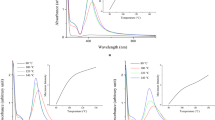Abstract
Highly fluorescent silver nanoparticles (AgFNPs) have been prepared by microemulsion method and the sizes of AgFNPs were controlled by altering the molar ratio (ω) of water-to-surfactant in the water-in-oil microemulsion. The results were shown that the AgFNPs sizes increased with incremental molar ratio (ω) of water-to-surfactant. The AgFNPs have been characterized by transmission electron microscopy, dynamic light scattering, fluorescence and absorption spectroscopy, and fluorescence lifetime study. Study of the spectral characteristics was shown that the absorbance of AgFNPs increased significantly with the ω, and linear relationship between absorbance and the size of AgFNPs was observed. The increase of AgFNPs size caused a red shift of maximum absorption wavelength in the UV–Vis spectra, and the relationship between maximum absorption wavelength and AgFNPs size appeared linear dependence. The maximum fluorescence emission wavelength did not shift with the change of particles size, but the emission intensity increases with the ω. The results were shown that the other factors to affect the fluorescence properties of AgFNPs were the surface properties and microstructure, except the AgFNPs size. These surface properties depend upon the stabilizing agent, reactant concentration, and solvents and so on.










Similar content being viewed by others
References
Aubin M-E, Morales DG, Hamad-Schifferli K (2005) Labeling ribonuclease S with a 3 nm Au nanoparticle by two-step assembly. Nano Lett 5:519–522
Banerjee S, Pabbathi A, Sekhar MC, Samanta A (2011) Dual fluorescence of ellipticine: excited state proton transfer from solvent versus solvent mediated intramolecular proton transfer. J Phys Chem A 115(33):9217–9225. doi:10.1021/jp206232b
Eklund SE, Cliffel DE (2004) Synthesis and catalytic properties of soluble platinum nanoparticles protected by a thiol monolayer. Langmuir 20:6012–6018
Fayaz M, Tiwary CS, Kalaichelvan PT, Venkatesan R (2010) Blue orange light emission from biogenic synthesized silver nanoparticles using Trichoderma viride. Colloid Surf B 75(1):175–178. doi:10.1016/j.colsurfb.2009.08.028
Fedrigo S, Harbich W, Buttet J (1993) Optical response of Ag2, Ag3, Au2, and Au3 in argon matrices. J Chem Phys 99(8):5712. doi:10.1063/1.465920
Gao X, Nie S (2004) Quantum dot-encoded mesoporous beads with high brightness and uniformity rapid readout using flow cytometry. Anal Chem 76:2406–2410
Grancharov SG, Zeng H, Sun S, Wang SX, O’Brien S, Murray CB, Kirtley JR, Held GA (2005) Bio-functionalization of monodisperse magnetic nanoparticles and their use as biomolecular labels in a magnetic tunnel junction based sensor. J Phys Chem B 109:13030–13035
Huang L, Zhai M, Peng J, Xu L, Li J, Wei G (2007) Synthesis, size control and fluorescence studies of gold nanoparticles. J Colloid Interface Sci 316:398–404. doi:10.1016/j.jcis.2007.07.039
Jian Z, Xiang Z, Yongchang W (2005) Electrochemical synthesis and fluorescence spectrum properties of silver nanospheres. Microelectron Eng 77(1):58–62. doi:10.1016/j.mee.2004.08.005
Le Guével X, Hötzer B, Jung G, Hollemeyer K, Trouillet V, Schneider M (2011) Formation of fluorescent metal (Au, Ag) nanoclusters capped in bovine serum albumin followed by fluorescence and spectroscopy. J Phys Chem C 115:10955–10963. doi:10.1021/jp111820b
Ledo-Suárez A, Rivas J, Rodríguez-Abreu CF, Rodríguez MJ, Pastor E, Hernández-Creus A, Oseroff SB, López-Quintela MA (2007) Facile synthesis of stable subnanosized silver clusters in microemulsions. Angew Chem Int Ed 46(46):8823–8827. doi:10.1002/anie.200702427
Li ZF, Ruckenstein E (2004) Water-soluble poly(acrylic acid) grafted luminescent silicon nanoparticles and their use as fluorescent biological staining labels. Nano Lett 4:1463–1467
Maretti L, Billone PS, Liu Y, Scaiano JC (2009) Facile photochemical synthesis and characterization of highly fluorescent silver nanoparticles. J Am Chem Soc 131:13972–13980
McFarland AD, Duyne RPV (2003) Single silver nanoparticles as real-time optical sensors with zeptomole sensitivity. Nano Lett 3:1057–1062
Moskovits M (2005) Surface-enhanced Raman spectroscopy: a brief retrospective. J Raman Spectrosc 36(6–7):485–496. doi:10.1002/jrs.1362
Petit C, Lixonf Pa, Pileni M-P (1993) In situ synthesis of silver nanocluster in AOT reverse micelles. J Phys Chem 97:12974–12983
Peyser LA (2001) Photoactivated fluorescence from individual silver nanoclusters. Science 291(5501):103–106. doi:10.1126/science.291.5501.103
Riboh JC, Haes AJ, McFarland AD, Yonzon CR, Duyne RPV (2003) A nanoscale optical biosensor real-time immunoassay in physiological buffer enabled by improved nanoparticle adhesion. J Phys Chem B 107:1772–1780
Rothrock AR, Donkers RL, Schoenfisch MH (2005) Synthesis of nitric oxide-releasing gold nanoparticles. J Am Chem Soc 127:9362–9363
Sánchez-González An, Corni S, Mennucci B (2011) Surface-enhanced fluorescence within a metal nanoparticle array: the role of solvent and plasmon couplings. J Phys Chem C 115(13):5450–5460. doi:10.1021/jp111196f
Sengupta B, Ritchie CM, Buckman JG, Johnsen KR, Goodwin PM, Petty JT (2008) Base-directed formation of fluorescent silver clusters. J Phys Chem C 112:18776–18782
Solanki JN, Murthy ZVP (2011) Controlled size silver nanoparticles synthesis with water-in-oil microemulsion method: a topical review. Ind Eng Chem Res 50(22):12311–12323. doi:10.1021/ie201649x
Vernon KC, Funston AM, Novo C, Gómez DE, Mulvaney P, Davis TJ (2010) Influence of particle–substrate interaction on localized plasmon resonances. Nano Lett 10(6):2080–2086. doi:10.1021/nl100423z
Wu Z, Jin R (2010) On the ligand’s role in the fluorescence of gold nanoclusters. Nano Lett 10(7):2568–2573. doi:10.1021/nl101225f
Xu H, Suslick KS (2010a) Sonochemical synthesis of highly fluorescent Ag nanoclusters. ACS Nano 4:3209–3214
Xu H, Suslick KS (2010b) Water-soluble fluorescent silver nanoclusters. Adv Mater 22(10):1078–1082. doi:10.1002/adma.200904199
Zhang D, Liu X, Wang X, Yang X, Lu L (2011) Optical properties of monodispersed silver nanoparticles produced via reverse micelle microemulsion. Phys B 406(8):1389–1394. doi:10.1016/j.physb.2011.01.035
Zheng J, Dickson RM (2002) Individual water-soluble dendrimer-encapsulated silver nanodot fluorescence. J Am Chem Soc 124:13982–13983
Zheng J, Ding Y, Tian B, Wang ZL, Zhuang X (2008) Luminescent and Raman active silver nanoparticles with polycrystalline structure. J Am Chem Soc 130:10472–10473
Acknowledgments
This research is financially supported by the National High-Tech Research and Development Plan of China (“863” plan, No. 2011AA06A107), the National Nature Science Foundation of China (21273073 and 21073063), and the Fundamental Research Funds for the Central Universities, China (No. WK0913002).
Author information
Authors and Affiliations
Corresponding author
Rights and permissions
About this article
Cite this article
Li, J.L., An, X.Q. & Zhu, Y.Y. Controllable synthesis and characterization of highly fluorescent silver nanoparticles. J Nanopart Res 14, 1325 (2012). https://doi.org/10.1007/s11051-012-1325-3
Received:
Accepted:
Published:
DOI: https://doi.org/10.1007/s11051-012-1325-3




